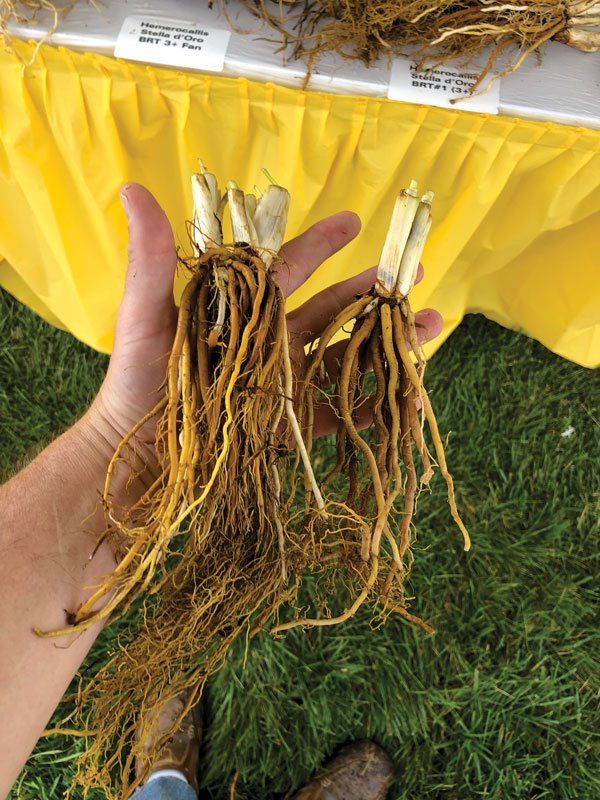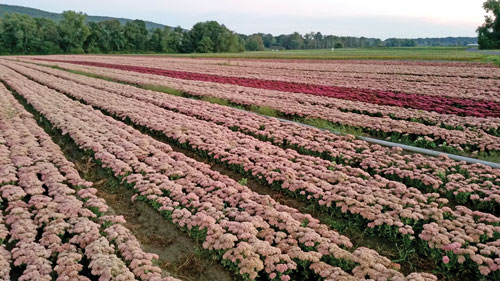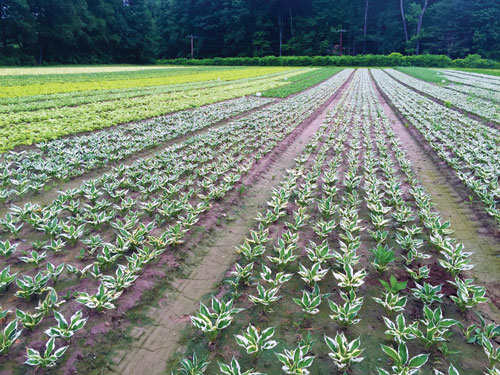8/1/2019
Perennials: The Bareroot Advantage
Paul Pilon

A bareroot perennial is essentially a plant that’s been grown in a field for a full growing season (sometimes longer) and harvested for use as starting materials for growers producing perennials in containers. The tops of the plants are usually trimmed above the crown, (evergreen perennials are typically not trimmed), the soil is removed from the roots (imported bareroot are also washed prior to shipping) and the roots are sometimes trimmed as well.
Pictured: Here’s a good visual showing the size differences between #1 Grade (left) and #2 Grade (right) bareroot of Hemerocallis Stella de Oro.
There are different grades available. The grades refer to the size of the plant and usually refers to the number of branches the bareroot starting material contains. The most common size is a #1 Grade. #1 Grade bareroot are commonly used for trade to true 1-gallon sized containers. #2 Grade bareroot are slightly smaller and more suitable for smaller trade 1 gallon or slightly smaller container sizes. Bareroot is also commonly marketed by the number of “eyes” or “fans” per plant. Bareroot with more eyes are suitable for large container sizes; conversely, starting materials with fewer eyes or fans are better suited for smaller containers.
Benefits of bareroot
With the convenience, efficiency and other benefits plugs and liners offer growers, it’s undeniable how valuable they are to today’s growers. However, there are some clear advantages with some perennials from utilizing bareroot starting materials.
• Small quantities—The most common perennial plug/liner tray sizes growers purchase contain 50 or 72 individual plants per tray. These quantities may seem nominal if you’re a medium- or large-sized grower, but for many small growers, even 50 plants can be more than they need. Bareroot is often available in quantities of 25, whichdoesn’t result in over-production or spending money on starting materials that don’t get planted.
• Vernalization—Many perennials either have a cold (vernalization) requirement for flowering or benefit from receiving a cold treatment. Each year, I come across spring-planted perennials from liners that required cold for flowering only to see them grow nicely, but fail to produce any blooms. Bareroot received in the late winter and spring are fully vernalized and will flower reliably—no more wondering if the liner supplier provided the proper amount of cold prior to shipping them. (Keep in mind that fall-planted bareroot will not be vernalized.)
• Shipping—Liners that haven’t been vernalized or have broken dormancy are susceptible to cold injury from freezing temperatures during transit in the late winter and early spring. Bareroot starting materials aren’t prone to this cold injury, as they’re usually dormant and have been in cold storage prior to shipping them.
 Pictured: Perennials being produced for bareroot starting materials are commonly grown in open fields, such as the sedum field at Pioneer Gardens in Deerfield, Massa-chusetts
Pictured: Perennials being produced for bareroot starting materials are commonly grown in open fields, such as the sedum field at Pioneer Gardens in Deerfield, Massa-chusetts
• Early season planting—With bareroot being shipped from cold storage, they’re not as susceptible to cold temperatures after planting. For this reason, many growers plant them earlier in the season into unheated covered structures or directly to outside growing areas. As a precaution, be prepared to provide protection from cold should freezing temperatures arise.
• Cooler temperatures—Since perennials from bareroot already have a full growing season under their belts and they don’t need warm temperatures to build a fuller plant, they can be grown cooler than many perennials started from plugs or liners. For many perennials from bareroot, it’s recommended to grow them at 50 to 60F (10 to 15C). Producing them cooler not only saves heating costs, it also results in higher-quality plants.
• Fuller containers—Some perennials plugs/liners are only a couple of months old before they’re shipped or placed into cold for vernalization. However, when bareroot starting materials are used, the plants are significantly older, have more branches and grow more vigorously than when smaller, younger inputs are used. This can reduce or eliminate the need for pinching and result in fuller containers faster.
• Grow them faster—With their larger size, perennials from bareroot can often be grown in 25% to 30% less production time (up to 50% in some instances) than when using smaller plugs or liners. With faster finishing times, growers can turn over their production space quicker.
Finally, is bareroot more expensive?
One thing I hear repeatedly is how bareroot starting materials costs more than plugs or liners. Does bareroot really cost more? Sure, the upfront cost of the inputs is usually more for bareroot starting materials, but when you consider the cost of growing each item and the effects longer growing times have on the actual production costs with smaller inputs, the edge usually shifts towards bareroot.
I’ve crunched the numbers dozens of times and encourage you to do the same, but when you take the overhead costs per square foot each week and multiply it by the number of weeks a liner is in production compared to a perennial from bareroot, the math often gives bareroot an advantage. Sometimes the cost savings is very small, but sometimes it’s very large.

Pictured: Hostas for bareroot production are also grown in open fields with full sun.
Taking an average, easy-to-grow perennial like a coreopsis, the final cost of producing a 1-gallon container is approximately $0.07 less with bareroot than the costs of starting them from liners. This $0.07 may not seem like a lot, but when 1,000 pots are being grown, the grower would realize a savings of $70.00. This still may not sound like much, but in today’s world, pennies count.
Now let’s look at an upright sedum—the input costs are twice as much for the bareroot, but the production time is half that required by smaller inputs. Get ready for this: In this scenario, the production cost with bareroot starting materials when time and overhead are taken into consideration is $0.44 less per container than when starting sedum from liners. This adds up to $440.00 per 1,000 pots in production. I thought that might grab your attention.
With the costs savings I’ve demonstrated with these two examples, I encourage you to perform your own calculations with your overhead costs and production times to see what your potential cost savings could be. I’m hopeful you, too, will see how important it is to look beyond the cost of the input when determining which starting materials to use.
The bareroot edge
I’m not suggesting that bareroot is the best starting materials for all perennials or situations; I certainly have my favorites, such as artemisia, astilbe, Coreopsis Moonbeam, hemerocallis, hosta, salvia and sedum to name a few. What I am implying is that bareroot offers many benefits that often get overlooked. With their larger size, bareroot can usually be grown in less time while producing fuller plants with less labor.
Bareroot starting materials may cost more upfront, but the actual production costs due to decreased production times could be less, making them more profitable than plants started from smaller, less-costly inputs. I encourage growers to do their own math and see if they can obtain “the bareroot edge.” GT
Paul Pilon is a horticultural consultant, owner of Perennial Solutions Consulting (www.perennialsolutions.com), author of “Perennial Solutions: A Grower’s Guide to Perennial Production” and editor of the Perennial Pulse newsletter. He can be reached at paul@perennialsolutions.com or
(616) 366-8588.